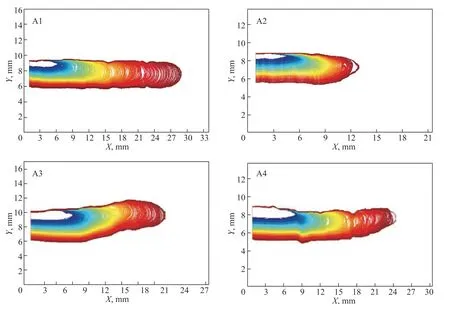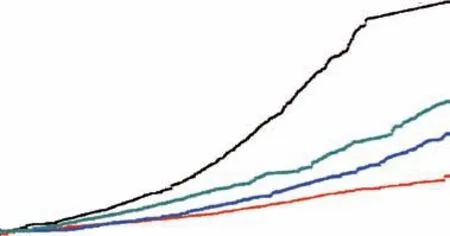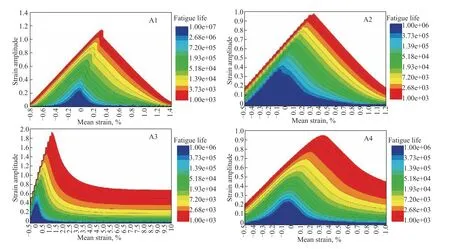Properties of Durable Magnetorheological Elastomers
2023-10-23WangJingWeiYintao
Wang Jing; Wei Yintao
(School of Vehicle and Mobility, Tsinghua University, Beijing 100084, China)
Abstract: Magnetorheological elastomers (MREs) are a type of intelligent material that can be actively controlled.However, the ferromagnetic particles in MREs are large, meaning that MREs contain many holes, which degrade the mechanical properties and fatigue resistance of MREs. In this work, liquid nitrile butadiene rubber-phenolic resin microcapsules were added as a self-healing agent to an MRE. The microcapsules reduced the number of holes caused by ferromagnetic particles and improved the mechanical properties and fatigue resistance of MREs. The magnetorheological effect of the MRE was not affected and was similar to that of the MRE without the self-healing agent. Under 100% strain and with the same number of cycles, the crack growth rate of the MRE without the self-healing agent was approximately 236% faster than that of the corresponding MRE with the self-healing agent and the crack length was approximately 136%longer.
Key words: functional; mechanical properties; magnetic materials; fatigue
1 Introduction
Magnetorheological (MR) materials, including MR fluids,MR elastomers, and MR foams, are MR smart materials with mechanical and rheological properties that can be controlled by external magnetic fields[1-4]. Unlike MR fluids, the viscosity of which varies with the magnetic field, magnetorheological elastomers (MREs) exhibit moduli that can be controlled by an external magnetic field. MREs have recently found a variety of applications,including adaptive tuned vibration absorbers, dampers,and sensors[5-10]. MREs generally consist of magnetizable particles, a matrix, and additives. Both natural rubber and silicone rubber are used as the matrix[11-12]. However, the main problem with MREs is their poor fatigue resistance.The fatigue resistance mechanism, material development,and process control of MREs have not been investigated thoroughly.
Rubber is used as the matrix material of MREs, which was first proposed by Rigbi and Jilkén[13]They mixed ferromagnetic particles into natural rubber to form an MRE. Unlike carbon black, white carbon black, and other reinforcing fillers, magnetic particles have no reinforcing effect and easily cause cracks in rubber, decreasing the life of MREs. Zhang et al.[14]studied the mechanical properties and morphological changes in ferromagnetic powder with mass fractions of 60%, 70%, and 80% in MREs under 105periodic stresses. The MR effect, storage modulus, and loss modulus of MREs containing 80%iron particles depended strongly on the strain amplitudes and number of cycles, whereas the storage modulus and loss modulus of MREs containing 70% iron particles depended less strongly on the strain amplitudes and the number of cycles. The properties of MREs containing 60% iron particles after cyclic deformation were almost independent of the fatigue conditions.
Initial cracks expand under external periodic stress,thus causing fatigue damage. There are many factors affecting the initial cracking of rubber products, including the matrix rubber, reinforcing systems, curing systems,aging systems, and plasticizers. Huneau et al.[15]studied a natural rubber system filled with carbon black and found that the cracking of rubber was caused by carbon black particles or ZnO particles. Sainumsai et al.[16]studied the effect of strain-induced crystallization on the crosslinking density of natural rubber, which was related to the initial cracks.
Under dynamic loading or deformation, cracks in rubber materials gradually increase and the mechanical properties decrease[17-19]. In the early 1920s, based on fracture mechanics, Griffith[20]proposed the crack growth energy criterion that the failure of materials starts from the largest defect, and that there is a defect distribution in any material. Rivlin and Thomas[21]applied this idea to rubber tearing and proposed the concept of tearing energy (strain energy release rate). Tao[22]studied the tearing energy,critical tearing energy, fatigue crack growth rate, and threshold value of 16 formulations of natural rubber. Lake et al.[23]found that the periodic crack growth rate was only related to the maximum tearing energy within the load cycle and that the tearing energy could be used as the only criterion for the fatigue crack growth rate of rubber materials. Mars and Fatemi[24]studied crack nucleation and propagation of natural rubber under periodic loading,the relationship between crack growth rate and tearing energy, and the relationship between crack growth and cycle number at different load ratios. They obtained the functional relation between the crack growth life and strain energy density under uniaxial loading.
Lindley[25]used the finite element method to calculate the tearing energy and studied the relationship between the tearing energy and crack size of several commonly used materials and simple shear-bonded rubber blocks.Wei et al.[26]proposed an improved virtual crack closure technique, and Shi and Liu[27]calculated the J-integral near the crack tip of a single-sided crack sample of type I rubber material with plane stress. They used the experimentally obtained crack growth rate to fit the relationship between the tearing energy and crack growth rate, and they combined this relationship with the relationship between the tearing energy and crack size to derive the MRE fatigue life model.
In this work, we examine the basic problems with MREs,namely, their initial cracks and fatigue life. We improve the fatigue life by adding a self-healing agent and form a relatively stable compound containing ferromagnetic particles.
2 Experimental
2.1 General remarks
Phenol (99.8%), formaldehyde (99.8%), polyvinyl alcohol(99%), and sodium hydroxide (99%) were purchased from Acros Organics. Deionized water was purchased from Beijing Chemical Reagent Co., Ltd. Liquid nitrile butadiene rubber was provided by Rayon Corporation.Coupling agent KH570 and ferromagnetic particles were purchased from Sinopharmaceutical Corporation.
Natural rubber (SMR L grade) and other chemicals,including zinc oxide nanoparticles, stearic acid, oil,N-1,3-dimethylbutyl-N'-phenyl-p-phenylenediamine (4020),N-tert-butylbenzothiazole-2-sulfenamide (NS), and sulfur,were all purchased from Zarm Scientific & Supplies Sdn.Bhd. (Penang, Malaysia). Carbon black (N330 and N660)was obtained from Jiangxi Black Cat Carbon Black Co., Ltd.
2.2 Preparation
2.2.1 Experimental formulation
The formulations of the MRE specimens are shown in Table 1.
The tensile strength and constant elongation stress of specimens A2, A3, and A4 were higher than those of specimen A1 (Table 2), which indicated that the addition of the self-healing agent improved the mechanical properties of MREs.

Table 2 Physical and mechanical properties of MREs
2.2.2 Preparation of the self-healing agent
Figure 1 shows the preparation of the self-healing agent.The molar ratio of phenol to formaldehyde was 1:1.2–3.0.Formaldehyde was reacted with 36% (mass fraction)aqueous solution and 3% NaOH as the catalyst at 90–95 °C for 3 h. A phenolic resin prepolymer solution was obtained, and then liquid nitrile rubber latex was addedand stirred. By adjusting the pH of the solution, liquid nitrile rubber-phenolic resin microcapsules with coreshell structures were obtained.

Figure 1 Schematic of the preparation of the self-healingagent
2.2.3 Preparation of MREs
Ferromagnetic particles, rubber, carbon black, and a complexing agent were added together and mixed in close mixer. When the temperature was up to 130 °C, rubber was discharged. Sulfur and accelerant can be added in open mixer or close mixer. Then, the mixture was injected into a mold and vulcanized with a flat-plate vulcanizing machine to obtain isotropic MREs. The specimen without the self-healing agent was named A1, and the specimens containing the self-healing agent were named A2, A3,and A4. The self-healing agent reacts with Fe to form coordination bonds (Figure 2).

Figure 2 Structure of the coordination compound of self-healing agent and Fe
2.3 Characterization
The morphologies of the self-healing agent particles and MREs were determined by a field-emission scanning electron microscope (SUPRA 55/55VP, Zeiss). Selfhealing agent particles and MREs were fixed on a film and sputtered to a thickness of approximately 15 nm to obtain scanning electron microscopy (SEM) samples.Mechanical properties were tested by using a universal material testing machine (6800, Instron) in accordance with the national standard GB/T 528–1992.
Figure 3 shows the rubber fatigue test specimen with prefabricated crack for the dynamic cyclic loading experiments. MREs sample inside crack tip position control through the crack growth driving force, and the crack propagation trajectory tracking, obtain the relationship between the crack propagation rate and crack growth driving force curve. The test conditions were as follows:sample size of 150 mm×15 mm ×2 mm; prefabricated notch length of 25 mm; cyclic load frequency of 10 Hz;and experimental temperature of 23 °C.

Figure 3 Schematic of rubber fatigue test specimens with a prefabricated crack
Three repeated crack propagation experiments were carried out on the target rubber material with three groups of samples. The maximum cyclic control tearing energy was gradually increased during the experiment, and the crack propagation morphology was monitored in real time.
The shear modulus test was performed on a rheometer(Rheo ComPass, Anton Paar). The sample was a wafer MRE 19 mm in diameter and 1.000 mm thick. The normal force for all test preloading was set to 10 N. The rheometer was heated with a water bath. According to the national standard, when the test temperature was reached, the sample was kept at the temperature for 10 min for testing.
3 Results and Discussion
3.1 SEM analysis
Figure 4 shows cross-sectional SEM images of MREs.For the same ferromagnetic particle content, the number of cavities caused by ferromagnetic particles was greatly reduced by the addition of the self-healing agent,which was expected to increase the strength and fatigue resistance of the material on the macroscale.

Figure 4 Cross-sectional SEM images of MRE specimens A1 and A3
3.2 Fatigue crack propagation
Figure 5 shows the fatigue crack propagation results and Figure 6 shows the relationship between crack growth results and fatigue life of the MRE specimens with different formulations under 100% strain. Under 100%strain and with the same number of cycles, the crack growth rate of specimen A1 was the fastest, and the crack length was the longest, indicating that specimen A1 had the lowest fatigue resistance (Figure 6, left). The crack growth rate of A1 was approximately 236% faster than that of sample A3 with the self-healing agent and the crack length was approximately 136% longer.

Figure 5 Fatigue crack propagation test results

Figure 6 Fatigue crack growth curve under 100% strain and relationship between fatigue crack growth rate and tearing energy of vulcanized MREs
The effects of strain on the fatigue crack growth rate were examined further (Figure 6, right). The crack growth rate increases rapidly in phases III and IV, and fatigue crack growth behavior in phase III is stable. Finally, the crack proceeds to unstable fatigue growth above the critical tearing energy, and the fatigue crack growth rate becomes infinite in phase IV[28-29]. The crack size in specimen A1 increased dramatically, indicating that the MRE without a self-healing agent had a faster fatigue crack growth rate as the tearing energy increased. This behavior greatly diminishes the ability of the material to resist fatigue damage. The crack growth rate was slower in specimens A2, A3, and A4 with the self-healing agent. In addition, as the ferromagnetic particle content increased, the fatigue resistance of the MREs decreased (A2 > A3 > A4).
Rubber materials are often highly deformed. If the average strain remains above 50%, according to Figure 7,the fatigue life of A2 was on the order of 105cycles when the control strain amplitude was below 0.5. When the strain was below 20%, the fatigue life of A1–A4 was on the order of 106cycles.

Figure 7 Haigh curves of vulcanized MREs
3.3 Shear modulus test
Figure 8 shows the change in the shear storage modulus of the MRE specimens with frequency. The strain variable control was fixed at 0.5%, the applied magnetic field was 800 mT, and the temperature was 23 °C. The storage modulus gradually increased with increasing frequency.

Figure 8 Shear modulus test results for MRE specimens
The A1, A2, A3, and A4 curves show that the MR effects of the MRE specimens were similar (Table 3)[30].Additionally, loss factor tanδalso showed little change,indicating that the MR effect of MREs was not affected by the addition of the self-healing agent.

Table 3 Shear modulus and MR effect at 100 Hz and 0.5% strain
4 Conclusions
A liquid nitrile butadiene rubber-phenolic resin microcapsule self-healing agent was added to MREs to reduce the holes caused by ferromagnetic particles and improve the mechanical properties and fatigue resistance of MRE materials. The conclusions are as follows: the self-healing agent reduced the number of holes caused by ferromagnetic particles and improved the mechanical properties and fatigue resistance of MRE materials. The MR effect of the MREs with the self-healing agent was not affected and was similar to that of the MRE without the self-healing agent. Due to their MR properties, these materials may have applications in many areas, such as bushings used as vibration isolators in industrial applications. In future work, we intend to process a bushing and we will focus on anisotropic MREs.
Acknowledgment:This research reported herein is sponsored by the following agencies: National Natural Science Foundation of China (52003142). The authors thank the Analysis and Test Center, Tsinghua University for use of their SEM, rheometer instruments, and mechanical facilities.
杂志排行
中国炼油与石油化工的其它文章
- Ultra-deep Removal of Metal Ions from Coal Tar by Complexation: Experimental Studies and Density Functional Theory Simulations
- A Metal-free Polyimide Photocatalyst for the Oxidation of Amines to Imines
- Effect of CeO2 on Activity of Catalysts CuO/ZnO/Al2O3/CeO2 for Synthesis of Methanol
- C9H10O2:0.5ZnCl2/SG as a High-Efficiency Catalyst for Desulfurization of Model Oil
- Effect of Mixed Dispersants on Suppression of the Gel Effect during Aqueous Adiabatic Terpolymerization of AM, NaAA, and DMC
- Pyrolysis Mechanism of a Cyclotriphosphazene-Based Flame-Retardant Epoxy Resin by ReaxFF Molecular Dynamics
